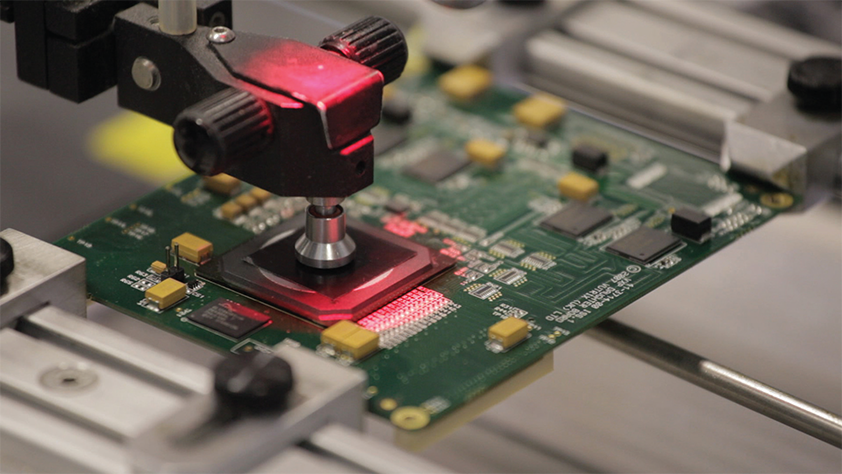
eXception EMS
Exceptional performance
Adam White, technical director, eXception EMS division, eXception Group, discusses high-performance electronics in oil and gas
As electronics become a central part of our everyday lives, so many companies are changing the way they manage and avert risk, allowing them to measure and control in new ways. The oil and gas industry especially relies heavily on these advanced technologies to develop reliable and innovative ways to optimise its business, as advancements in offshore drilling, hydraulic fracturing and other technologies are making it possible to recover oil and gas from greater depths and in harsher environments.
The high price of oil has helped fund research into extracting oil from these more difficult places, both onshore and offshore. Instrumentation designed to work in this environment is constantly being challenged, and we’ve recently seen a proliferation of electronics devices appear for some of these most difficult environments, including the most challenging to date – downhole.
With the world’s accessible oil already extracted, this need for contractors to drill deeper is putting stress on the components and materials deployed in an already harsh environment. As the drill bit goes deeper, so the temperature rises reaching well over 200oC, which traditional electronics materials are unable to cope with.
A drive for high levels of functionality in products designed to measure performance in a downhole environment, such as sensors within drill heads that can measure depth, vibration and temperature, has seen the electronics change from simple low technology ‘conservative’ designs to ones now using technology normally seem in mobile phones – e.g. 0.5mm pitch Ball Grid Arrays, small (<1mm) chip components and high performance silicon, but these complex designs still have to survive the high temperature and vibration experienced in a drilling rig. One example of this is the accurate vibration sensor that lives right behind the drill bit, this has five PCBAs with a high specification digital signal processor, radio comms and flash memory which all fits into a 100x40mm metal tube. So the major challenge for electronics manufacturers is to develop technology that will allow for increasing data to be delivered, in ever-smaller devices, in harsher environments.
 High Melt Point solder techniques becoming crucial
High Melt Point solder techniques becoming crucial
Electronics in the oil industry is accustomed to the use of different solder alloys to achieve strong joints at higher temperatures. In fact, high temp alloys SN96 and 99C (Sn96Ag4, Sn99.3Ag0.7) were being used before the EU RoHS legislation (2002/95/EC) had moved the rest of us away from tin/lead. The performance of these alloys is no longer sufficient and different alloys are needed to provide the tensile strength required at the new higher temperatures. Each of these have their own challenges (Pb85 poor solderability, Au80 prohibitively expensive) but the alloy that is currently getting the most focus is HMP (High Melt Point) (Pb93.5,Sn5,Ag1.5). This alloy has great tensile strength at high temperature and flows well when liquid. The main problem is that its melt point (301degC) means that the processing temperature of current automated manufacturing methods is so hot that the silicon devices within the manufacturing process can get damaged. However, new manufacturing equipment that will help solve this problem is on the horizon, driven by the demand created by the industry.
More ruggedised products for more challenging environments
Current oil and gas electronics need to also go through a ruggedisation programme to ensure they can physically survive the working environment. This normally involves an amount of mechanical adhesive to support the joints and some kind of coating and potting to ensure physical separation from the elements, care has to be taken to ensure that at the extremes of temperature and pressure the CTEs (coefficients of thermal expansion) are matched through the product, to ensure no undue stress is put on the joints that might cause premature failure. In such critical devices being used in the oil and gas industry, this ruggedisation is a necessity – indeed one of our customers develops one drill head control product, which uses up to five different products for ruggedisation. This includes mechanical adhesive for big parts to aid vibration proofing; a white ceramic product to help heat dissipation; a conformal coat for electronics protection; a potting compound to protect the hole assembly and a foam to stop materi l going where it shouldn’t and causing a CTE mismatch.
Heat sinking becoming more prevalent
Working electronics create heat, even when they are hot already. This problem will become more acute as the environment gets hotter. Methods of heat sinking the electronics to the fluid in the well will become more important and methods like banked thermoelectric coolers (a solid state electric cooler) may need to be considered to keep the junction temperature of the silicon down to optimise working life.
Conclusion
Oil and gas exploration projects are increasingly driving the need for specialist electronics to help manage the wells better and more economically. In the future, high performance electronics will be working downhole, both at the drill bit and behind it, in the most demanding environments -monitoring and controlling a plethora of variables such as angle and direction, oil logging, radiation, rock conditions and pressure. Parts must be proven and tested, as electronics become an increasingly critical element of these devices.
eXception EMS